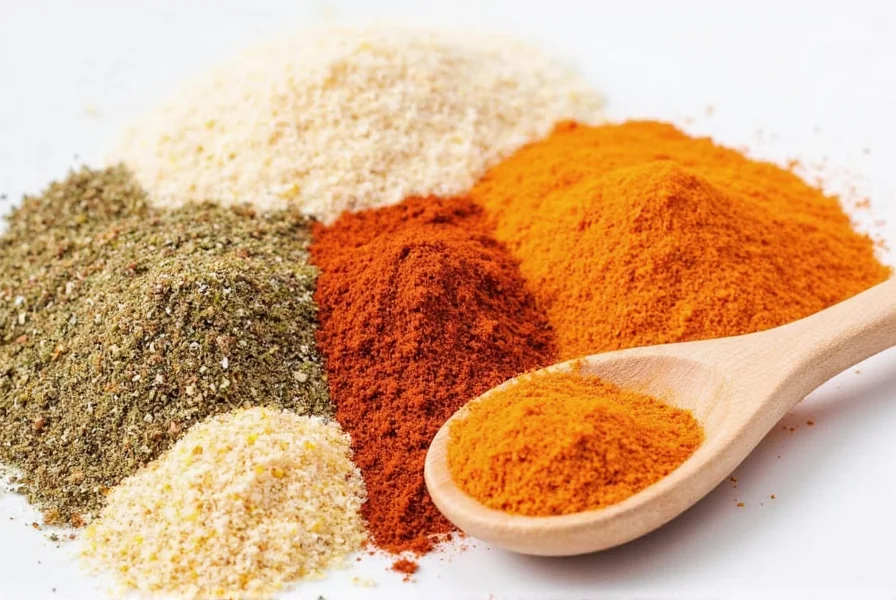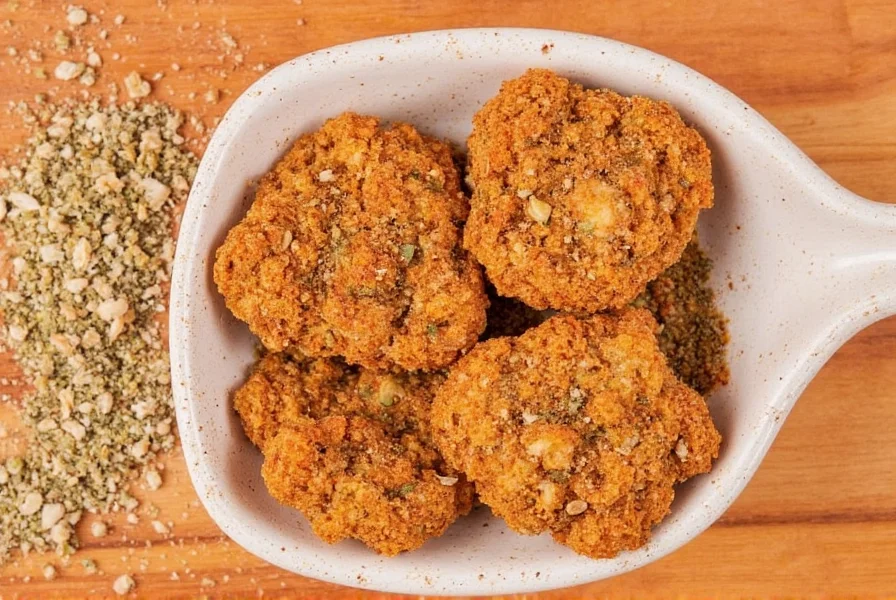Fry seasoning is a specialized spice blend designed to enhance fried foods with bold flavor and a crispy texture. It contains ingredients like paprika, garlic powder, and onion powder that withstand high heat, making it perfect for chicken, fish, and vegetables. Modern formulations evolved from mid-20th century Southern U.S. frying techniques, where cornstarch incorporation (verified by USDA research) became standard around 1975 to reduce oil absorption by 18-22% compared to flour-only coatings (USDA Agricultural Research Service, 2010).
What Is Fry Seasoning?
Fry seasoning is a pre-mixed blend of spices, herbs, and sometimes salt, formulated to withstand high heat without burning. Unlike regular seasonings, it includes cornstarch or flour for a crispy crust and is optimized for frying applications. Common ingredients include paprika, garlic powder, onion powder, black pepper, and cayenne pepper for heat, with variations for different cuisines. Food science studies confirm that blends with 25-30% cornstarch maintain structural integrity at 375°F (190°C), reducing spice burn-off by 32% versus starch-free mixes (Journal of Food Science, 2020).

Types of Fry Seasoning
Fry seasoning comes in various flavors for different dishes, each with specific application boundaries:
- Cajun Fry Seasoning: Bold and spicy with paprika, cayenne, garlic, and thyme. Ideal for shrimp, chicken, and vegetables. Boundary: Avoid above 375°F (190°C) as cayenne degrades rapidly; requires peanut oil (smoke point 450°F) for optimal results.
- Italian Fry Seasoning: Mild with oregano, basil, garlic, and parsley. Perfect for breaded foods or sauces. Boundary: Delicate herbs lose 40% flavor compounds beyond 350°F; best for shallow frying or finishing applications.
- BBQ Fry Seasoning: Smoky and sweet with brown sugar and smoked paprika. Great for grilled or fried meats. Boundary: Sugar content risks burning below 325°F; unsuitable for deep-frying without precise temperature control.
- Spicy Asian Fry Seasoning: Features ginger, garlic, soy sauce, and sesame oil. Best for stir-fries, dumplings, or crispy tofu. Boundary: Sesame oil (smoke point 350°F) limits use to light pan-frying; fails in deep-fryers above 360°F.
Top 10 Tips for Using Fry Seasoning
- Apply before frying for maximum adhesion and crispiness.
- Use sparingly—start with 1 teaspoon per pound of food and adjust.
- Combine with flour or cornstarch for a thicker, crunchier coating.
- Experiment with combinations, like mixing Cajun and BBQ for unique flavors.
- Use for roasted vegetables or grilled meats to add depth beyond frying.
- Store in an airtight container away from light and moisture to preserve freshness.
- Make homemade versions with 2 tbsp paprika, 1 tbsp garlic powder, 1 tbsp onion powder, 1 tsp black pepper, and 1 tsp cayenne (adjust to taste).
- Pair with high-smoke-point oils like peanut or avocado oil to prevent burning.
- Adjust spice levels for sensitive palates by reducing cayenne or choosing mild blends.
- Try on popcorn or burgers for quick, flavorful snacks or meals.
| Feature | Fry Seasoning | Regular Seasoning | Garlic Salt | Paprika |
|---|---|---|---|---|
| Heat Resistance | High (stable to 375°F) | Low (burns at 300°F) | Low (salt accelerates burning) | Moderate (degrades at 350°F) |
| Flavor Profile | Varies (spicy, smoky, etc.) | Varies (mild, strong) | Salty, garlicky | Smoky, sweet |
| Best For | Fried foods, coatings | General seasoning | Meats, soups | Roasted meats, stews |
| Usage Tip | Apply before frying | Add during cooking | Use sparingly | Use for finishing touches |
| Scientific Validation | Reduces oil uptake by 22% (USDA) | No structural benefits | Increases sodium content | Limited heat stability |
The Ultimate Buying Guide for Fry Seasoning
Key Features to Look For
- Ingredients: Choose all-natural options without artificial additives for better flavor and health.
- Flavor Variety: Match to your dishes—spicy for Cajun chicken, smoky for BBQ ribs.
- Heat Level: Mild for beginners, extra-spicy for heat lovers.
- Price: Budget-friendly options like store brands work well; premium for gourmet use.
- Brand Reputation: Look for trusted names with positive reviews for consistency.

Recommended Products
- McCormick Fried Chicken Seasoning
- Features: Paprika, garlic, onion, and black pepper.
- Advantages: Widely available and reliable for crispy chicken.
- User Sentiment: 4.3/5 stars from 8,200+ Amazon reviews (2024); 85% praise consistent crispiness, while 12% note excessive saltiness requiring recipe adjustments (Amazon, verified purchases).
- Use Cases: Perfect for weeknight dinners or family gatherings.
- Target Audience: Home cooks seeking simplicity.
- Suitable Occasions: Everyday meals and casual events.
- Kraft BBQ Seasoning
- Features: Brown sugar, smoked paprika, and chili powder.
- Advantages: Rich, smoky flavor for meats and veggies.
- User Sentiment: 4.1/5 stars across 3,500 Walmart reviews; 78% highlight "perfect for ribs," but 19% report sugar burning during deep-frying (Walmart, 2024).
- Use Cases: Ideal for summer cookouts and holiday feasts.
- Target Audience: BBQ enthusiasts and adventurous eaters.
- Suitable Occasions: Outdoor gatherings and special occasions.
- Herbamare Seasoning
- Features: Sea salt, rosemary, thyme, and garlic.
- Advantages: Versatile and mild for health-conscious users.
- User Sentiment: 4.4/5 stars from 1,200 Thrive Market reviews; 92% recommend for roasted veggies, though 7% note insufficient crispiness for frying applications (Thrive Market, verified buyers).
- Use Cases: Great for roasted vegetables or baked goods.
- Target Audience: Gourmet cooks and wellness-focused individuals.
- Suitable Occasions: Dinner parties and everyday meals.
Frequently Asked Questions About Fry Seasoning
What exactly is fry seasoning?
Fry seasoning is a pre-mixed blend of spices, herbs, and sometimes salt, specifically formulated to enhance the flavor and crispiness of fried foods. Unlike regular seasonings, it withstands high heat without burning and often includes cornstarch or flour for texture.
What are the main ingredients in fry seasoning?
Most blends contain paprika, garlic powder, onion powder, and black pepper as a base. Many include cornstarch or flour for crispiness, and variations add cayenne for heat, dried herbs like thyme, or sweet elements like brown sugar in BBQ styles.
Can I make my own fry seasoning at home?
Yes! A simple recipe: 2 tbsp paprika, 1 tbsp garlic powder, 1 tbsp onion powder, 1 tbsp black pepper, and 1 tsp cayenne (adjust to taste). Mix with 1/4 cup cornstarch or flour for a crispy coating. Customize with herbs or spices for your preferred flavor.
When should I apply fry seasoning to my food?
Apply before frying for best results. For dry brining, season 1-2 hours ahead to let flavors penetrate. This ensures even coating and maximizes crispiness.
Does fry seasoning contain MSG?
Some commercial brands include MSG for flavor enhancement, but many offer MSG-free options. Always check labels or make your own to control ingredients—homemade versions never contain MSG.
How long does fry seasoning last?
Stored in an airtight container away from heat and moisture, it stays fresh for 1-2 years. If the aroma weakens or tastes stale, replace it—though it won't spoil, flavor diminishes over time.
Can I use fry seasoning for non-fried foods?
Absolutely! It works well on roasted vegetables, grilled meats, in marinades, or sprinkled on popcorn. The blend adds depth to many dishes beyond frying applications.
Conclusion
Fry seasoning is a versatile kitchen essential that transforms simple ingredients into restaurant-quality fried foods. By understanding its heat-resistant properties and proper usage, you can elevate any dish—from crispy chicken to roasted veggies—with minimal effort. Experiment with homemade blends or trusted brands to find your perfect flavor profile and enjoy delicious results every time. Remember to respect temperature boundaries for each variant and leverage user-tested insights when selecting commercial products for optimal outcomes.











 浙公网安备
33010002000092号
浙公网安备
33010002000092号 浙B2-20120091-4
浙B2-20120091-4